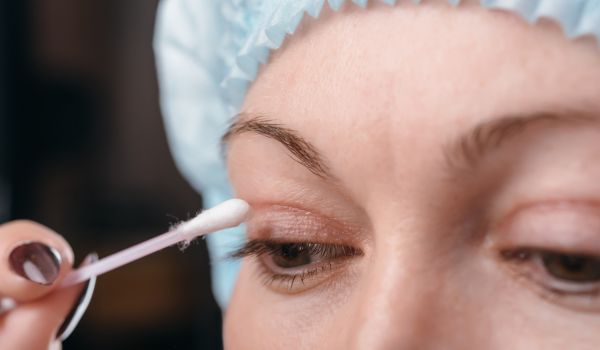Why Eyelid Ptosis Occurs and How to Treat It
Have you ever looked in the mirror and felt like your eyelids were drooping, making you look tired and older than you actually are? If so, you may be experiencing a common condition known as eyelid ptosis. Eyelid ptosis can be caused by a variety of factors, and it can cause not only cosmetic concerns but also functional problems such as obstructed vision and eye fatigue. In this article, we will explore the causes and symptoms of eyelid ptosis, how it is diagnosed, and the various treatment options available to help you achieve a more youthful and refreshed appearance.
Mr Mark Gittos is one of the top plastic surgeons in UK for face surgery. He is dedicated to helping his patients achieve their desired results by utilising state-of-the-art techniques and tailoring each surgery to the individual’s unique needs.
Download Mr Mark Gittos’ Guide to Eyelid Lift Surgery – Blepharoplasty

What Causes Droopy Eyelids?
Eyelid ptosis is caused by the weakening or stretching of the levator muscle, which is responsible for lifting the eyelid. This can be due to a variety of factors, including ageing, genetics, injury, and certain medical conditions.
As we age, the skin around our eyes loses elasticity, and the muscles that support the eyelids become weaker. This can cause the eyelids to droop or sag, making us look tired or older than we actually are.
In some cases, eyelid ptosis can be present from birth or develop in childhood due to a congenital defect.
In addition to ageing, certain medical conditions can also cause eyelid ptosis. These include neurological disorders such as myasthenia gravis, which affects the muscles that control eye movement, and Horner’s syndrome, which affects the nerves that control the muscles in the face and eyes.
If you suspect that your eyelid ptosis may be due to a medical condition, it is important to consult with your doctor to rule out any underlying issues.
Symptoms of Eyelid Ptosis
The most obvious symptom of eyelid ptosis is drooping or sagging of the upper eyelid. This can cause a variety of cosmetic concerns, including making you look tired or older than you actually are. In addition to cosmetic concerns, eyelid ptosis can also cause functional problems such as obstructed vision and eye fatigue.
If your eyelid ptosis is severe, it may completely cover your pupil, making it difficult to see clearly. This can cause eye strain, headaches, and even double vision. In some cases, people with eyelid ptosis may compensate by raising their eyebrows or tilting their head back to see better, which can lead to neck and shoulder pain over time.
How is Eyelid Ptosis Diagnosed?
If you suspect that you have eyelid ptosis, it is important to consult with an ophthalmologist or a plastic surgeon who specialises in eyelid surgery. They will perform a thorough eye exam and evaluate the extent of your ptosis, as well as any underlying medical conditions that may be contributing to the problem.
In some cases, your doctor may perform a visual field test to determine the extent of your vision loss due to eyelid ptosis. This test involves looking at a screen and indicating when you can see a flashing light in your peripheral vision. If your eyelid ptosis is severe, it may be affecting your peripheral vision, which can be dangerous when driving or performing other tasks that require good vision.
Treatment Options for Eyelid Ptosis

There are several treatment options available for eyelid ptosis, ranging from non-surgical remedies to more invasive surgical procedures. The best treatment option for you will depend on the severity of your ptosis, your overall health, and your personal preferences.
Non-Surgical Solutions for Droopy Eyelids
If your eyelid ptosis is mild to moderate, you may be able to improve its appearance with non-surgical solutions. These include:
· Eye exercises
Eye exercises can help strengthen the muscles around your eyes, which can improve the appearance of eyelid ptosis. These exercises may include looking up and down, side to side, and in a circular motion. Your doctor or a licensed physical therapist can recommend specific exercises based on your individual needs.
· Botox injections
Botox injections can be used to lift the eyebrows, which can help improve the appearance of eyelid ptosis. This is a temporary solution that typically lasts around 3-4 months.
Surgical Options for Eyelid Ptosis
If your eyelid ptosis is severe or causing functional problems, you may need to consider surgical options. These include:
1. Levator resection
Levator resection is a surgical procedure that involves shortening the levator muscle to lift the eyelid. This is the most common surgical treatment for eyelid ptosis and has a high success rate.
2. Frontalis sling surgery
Frontalis sling surgery is a procedure that involves attaching a small sling to the eyebrow muscles, which can help lift the eyelid. This procedure is typically reserved for patients with severe eyelid ptosis and can be performed in conjunction with levator resection.
3. Blepharoplasty
Blepharoplasty procedure entails the excision of excess skin from the level of upper or lower eyelid. In the case of eyelid ptosis, the excision is made at the level of the upper eyelid.
4. Brow lift surgery
Brow lift surgery is a procedure that involves lifting the eyebrows to improve the appearance of eyelid ptosis. This procedure is often recommended for patients with significant brow droop and can be performed in conjunction with other eyelid surgery procedures.
Differences between Different Eyelid Ptosis Surgery
Levator resection is a surgical procedure that involves shortening the levator muscle to lift the eyelid. This surgery is performed under local anaesthesia, and it is typically an outpatient procedure. Levator resection is a good option for patients with mild to moderate ptosis, and it can provide long-lasting results.
Frontalis sling surgery, on the other hand, connects the eyelid to the brow with a sling material and uses the power of the frontalis muscle to lift the eyelid. This surgery is usually reserved for patients with more severe ptosis, and it may not be appropriate for patients with weak frontalis muscles.
Blepharoplasty is a cosmetic procedure that is done to remove excess skin, fat, and muscle from the eyelids. This procedure can improve the appearance of the eyes, aside from correcting eyelid ptosis.
Brow lift is a surgical procedure that is done to lift the eyebrows and improve the appearance of the upper face. This procedure can also correct ptosis by lifting the forehead and pulling the skin around the eyes upward. However, a brow lift may not be appropriate for patients with mild to moderate ptosis.
There are several different types of eyelid ptosis surgery, each with its own benefits and drawbacks. Levator resection is suitable for patients with mild to moderate ptosis, while frontalis sling surgery is appropriate for more severe cases. Blepharoplasty is a cosmetic procedure that can improve the appearance of the eyes. A brow lift can correct ptosis by lifting the forehead and pulling the skin around the eyes upward. It is essential to discuss your specific needs with a qualified surgeon to determine which procedure is right for you.
Recovery and Aftercare for Eyelid Ptosis Surgery

If you undergo eyelid ptosis surgery, it is important to follow your plastic surgeon’s instructions for recovery and aftercare. This may include:
- Resting and avoiding strenuous activities for several weeks after surgery
- Applying ice packs to reduce swelling and bruising
- Using prescribed eye drops or ointments to prevent infection and promote healing
- Avoiding rubbing or touching your eyes for several weeks after surgery
In most cases, you will be able to return to work and normal activities within 1-2 weeks after surgery. However, it may take several months for the final results of the surgery to become apparent.
Preventing Eyelid Ptosis
While there is no guaranteed way to prevent eyelid ptosis, there are several things you can do to reduce your risk, such as:
- Protecting your eyes from injury by wearing safety glasses or goggles when working with tools or participating in sports
- Maintaining a healthy lifestyle, including eating a balanced diet and getting regular exercise
- Avoiding smoking and excessive alcohol consumption, which can contribute to premature ageing of the skin
- Wearing sunglasses to protect your eyes from UV radiation, which can cause skin damage and premature ageing
Eyelid ptosis is a common condition that can cause both cosmetic and functional problems. Whether you are dealing with mild drooping or severe ptosis, there are a variety of treatment options available to help you achieve a more youthful and refreshed appearance.
FAQs about Eyelid Ptosis and Surgical Solutions to Correct It

Can eyelid ptosis go away without treatment?
- Eyelid ptosis can sometimes go away without treatment, depending on the underlying cause. If the ptosis is caused by fatigue, the muscles around the eyelids may eventually strengthen and the condition may improve. However, if the ptosis is caused by a more serious condition, such as a neurological disorder or ageing, it is unlikely to go away on its own and may even worsen over time. It is important to consult with a healthcare professional if you are experiencing eyelid ptosis to determine the underlying cause and the appropriate course of treatment.
Can you fix eyelid ptosis with natural remedies?
- While there are no proven natural remedies for eyelid ptosis, some people may find relief from certain lifestyle changes. For example, getting enough rest, reducing stress, and avoiding alcohol and drugs can help improve overall muscle tone and reduce fatigue, which may contribute to droopy eyelids. Additionally, some people find that doing regular eye exercises or using warm compresses on the eyes can help improve muscle strength and circulation in the area. However, it is important to note that these remedies have not been scientifically proven to treat eyelid ptosis and should not be used as a substitute for professional medical advice and treatment.
Can lack of sleep cause ptosis?
- Yes, lack of sleep can cause ptosis or droopy eyelids. When we don’t get enough sleep, our body produces less collagen, which is an essential protein that helps keep our skin and muscles toned and firm. This reduction in collagen production can cause the muscles around the eyes to weaken, leading to droopy eyelids. Additionally, lack of sleep can cause fluid retention, which can also contribute to swelling and drooping of the eyelids. If you are experiencing ptosis and have not been getting enough sleep, it is important to prioritise rest and establish healthy sleep habits to help improve muscle tone and reduce fatigue in the area.
Can too much screen time cause ptosis?
- While there is no direct link between too much screen time and ptosis, excessive screen time can contribute to eye strain, fatigue, and dryness, which may cause temporary drooping or swelling of the eyelids. Additionally, when we spend long periods looking at screens, we tend to blink less, which can lead to dryness and irritation in the eyes, making them feel heavy and tired. This may cause the muscles around the eyes to weaken, leading to temporary ptosis. However, it is important to note that other factors, such as ageing, genetics, and underlying medical conditions, are more likely to cause ptosis.
Further Reading about Eyelid Surgery with Mr Mark Gittos
- Read Mr Mark Gittos’ blog about Five Biggest Mistakes Surgeons make with Eyelid Surgery
- Read Mr Mark Gittos’ blog about What Is Tear Trough Deformity?
- Read Mr Mark Gittos’ blog about Solutions for Bags under the Eyes and Dark Circles
- Read Mr Mark Gittos’ blog about How Long Does It Take for Stitches to Dissolve after Blepharoplasty?
- Read Mr Mark Gittos’ blog about What Causes Lumps after Blepharoplasty?
- Read Mr Mark Gittos’ blog about What is the Best Ectropion Repair Eyelid Surgery?
Medical References about Eyelid Ptosis
- Droopy eyelid (ptosis): Causes, risk factors, and treatment
- How to fix droopy eyelids: Surgical and nonsurgical methods
- Ptosis Of Eyelid | Medical news – Medpage Today
- Ptosis (Droopy Eyelid): Causes & Treatment – Cleveland Clinic
- What Is Ptosis? – American Academy of Ophthalmology
About Mr Mark Gittos FRACS (Plast) – London Plastic Surgeons
Practice locations in London & Essex, UK and Auckland, New Zealand.
Mr Mark Gittos offers high quality, natural-looking cosmetic surgery results and is highly experienced in Breast, Body and Face Surgery having performed over 4000 Surgeries in the last 26 years.
With world-wide expertise Mr Gittos is an expert in breast, face and body surgery for men & women.
Mr Mark Gittos is a leading Specialist Plastic Surgeon and operates a practice in London UK and Auckland New Zealand. His practice focuses on both surgical and non-surgical procedures, each designed to help restore, improve or change a physical characteristic or problem. The first step in every case is to talk through your personal requirements and explore all the options, before deciding on the most effective solution.
Naturally, before any treatment is begun, we will explain clearly the advantages and risk factors; so that you have the information you need to make an informed decision that is best for you. Visit the practice to find out more.

NEXT STEPS
Do your Research
- Read the Website and Blogs relevant to your procedure
- Browse our Frequently Asked Questions including how to choose a Surgeon for your procedure
- Download the Guides to Surgery
What to Bring to your Plastic Surgeon Consultation
- Bring a friend or relative to help discuss the information and your choices
- Take lots of notes and read the documents provided thoroughly
- Want more information before scheduling your consultation?
Book your Initial Surgery Consultation
- A Referral from your GP or specialist is helpful but NOT essential – you can have a consultation without a GP Referral
- Email us or Call in London on 07557 858156 to arrange your surgeon consultation appointment.
- Book a consultation with Mr Gittos by paying the Consultation Fee
Please contact us to arrange to book a consultation with our Specialist Plastic Surgeon or to speak with our Patient Care Advisor.
Send an enquiry form today or UK phone 07557 858156 during Clinic Hours
